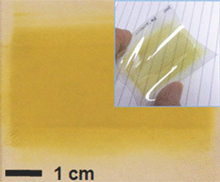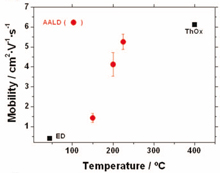Chemical growth and characterization of physical properties of transparent and conductive p-type oxide layers based on Cu(I).
Non permanent staff- Hongjun Liu (PhD student)
- Joao Resende (PhD student)
- Tyndal Institute, Cork (Ireland), Dr. M. Modreanu
- University of Catania (Italy), Prof. G. Malandrino,
- Université de Liège (Belgium), Prof. N.D. Nguyen
Domains of interest
Doped/substituted Copper oxides thin films by MOCVD or aerosol assisted CVD
Our work is particularly centered in the improvement of the electrical properties of Cu2O by studying the effect of the Cu substitution by different cations (Sr, Mg, Ni,…) in relation with published ab initio calculation. Thin films with different Sr or Mg content were deposited by MOCVD or AAMOCVD. It was found that the cubic phase was maintained for doping up to 14% with an additional SrCO3 impurity phase in the case of Sr concentrations higher than 5%. Cation doping had a strong influence on the film morphology and resistivity. The study of the electrical properties as a function of Sr concentration highlight a copper vacancy doping mechanism induced by strontium incorporation, leading to a large decrease of the resistivity as low as 1.2 ?·cm and corresponding free carrier mobilities about 15 cm2·V–1·s–1 at room temperature. Moreover, in addition to the main copper vacancy acceptor level, found at EA1 = 278 ± 21 meV above the top of the valence band, a coexisting shallower acceptor level with an ionization energy of EA2 = 133 ± 15 meV occurs for a strontium content above 5% and this level could be assigned to a large size impurity–vacancy complex.

Contact
Team (Permanent staff)
FM2N Research topics
- Nanowires, Thin Films & Heterostructures as ...
- Wet Chemistry & Surface Functionalization
- Transparent Conducting Materials
- Physical Chemistry at Interfaces, advanced structural characterization
copper (I) oxide by spatial ALD (SALD)
Phase pure, dense Cu2O thin films were grown on glass and polymer substrates at T ? 225 ºC by rapid atmospheric spatial atomic layer deposition (SALD). Growth rates were ?1nm/min which is two orders of magnitude faster than conventional ALD. The high mobilities achieved using the atmospheric, low temperature method represent a significant advance for flextronics and flexible solar cells which require growth on plastic substrates.


(left) Optical photograph (film deposited at 150 °C on glass or on polymer substrate (inset); (right) Mobility values as a function of temperature.
(Muñoz-Rojas et al, AIP Advances, 2012)
Main publications
Effect of Strontium Incorporation on the p-Type Conductivity of Cu2O Thin Films Deposited by Metal–Organic Chemical Vapor Deposition, The Journal of Physical Chemistry C 120 (31), 17261–17267 (2016)
A. Khan, C. Jiménez, O. Chaix-Pluchery, H. Roussel and J.-L. Deschanvres,
Effect of thermal annealing on electrical and optical properties of Ba-doped SrCu2O2 thin films on glass substrates, Physica Status Solidi A, 210-12 ( 2013).
“Magnesium-doped cuprous oxide (Mg:Cu2O) thin films as a transparent p-type semiconductor”
J; Resende, C. Jiménez, N.D. guyen, J.-L. Deschanvres.
Physica Status Solidi (A) Applications and Materials Science, 213, Issue 9 (2016) 2296-2302, DOI: 10.1002/pssa.201532870
D. Muñoz-Rojas, M. Jordan, C. Yeoh, A. T. Marin, A. Kursumovic, L. A. Dunlop, D. C. Iza, A.Chen, H. Wang, J. L. MacManus Driscoll,
Growth of ?5 cm²/V/s mobility, p-type Copper(I) oxide (Cu2O) films by fast atmospheric atomic layer deposition (AALD) at 225°C and below, AIP Advances, 2(4), 042179, (2012)



